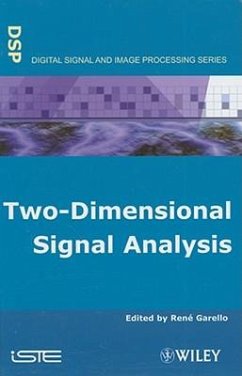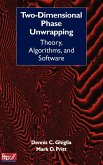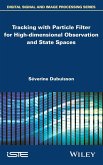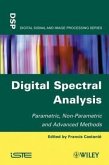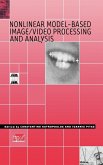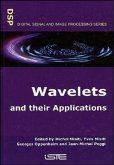Two-Dimensional Signal Analysis
Herausgeber: Garello, René
Two-Dimensional Signal Analysis
Herausgeber: Garello, René
- Gebundenes Buch
- Merkliste
- Auf die Merkliste
- Bewerten Bewerten
- Teilen
- Produkt teilen
- Produkterinnerung
- Produkterinnerung
This title sets out to show that 2-D signal analysis has its own role to play alongside signal processing and image processing. Concentrating its coverage on those 2-D signals coming from physical sensors (such as radars and sonars), the discussion explores a 2-D spectral approach but develops the modeling of 2-D signals and proposes several data-oriented analysis techniques for dealing with them. Coverage is also given to potential future developments in this area.
Andere Kunden interessierten sich auch für
![Two-Dimensional Phase Unwrapping Two-Dimensional Phase Unwrapping]() Dennis C. GhigliaTwo-Dimensional Phase Unwrapping250,99 €
Dennis C. GhigliaTwo-Dimensional Phase Unwrapping250,99 €![Digital Filters Design for Signal and Image Processing Digital Filters Design for Signal and Image Processing]() Digital Filters Design for Signal and Image Processing345,99 €
Digital Filters Design for Signal and Image Processing345,99 €![Two-Dimensional Digital Filters Two-Dimensional Digital Filters]() Wu-Sheng LuTwo-Dimensional Digital Filters183,99 €
Wu-Sheng LuTwo-Dimensional Digital Filters183,99 €![Tracking with Particle Filter for High-Dimensional Observation and State Spaces Tracking with Particle Filter for High-Dimensional Observation and State Spaces]() Séverine DubuissonTracking with Particle Filter for High-Dimensional Observation and State Spaces189,99 €
Séverine DubuissonTracking with Particle Filter for High-Dimensional Observation and State Spaces189,99 €![Digital Spectral Analysis Digital Spectral Analysis]() Digital Spectral Analysis202,99 €
Digital Spectral Analysis202,99 €![Nonlinear Model-Based Image/Video Processing and Analysis Nonlinear Model-Based Image/Video Processing and Analysis]() Nonlinear Model-Based Image/Video Processing and Analysis217,99 €
Nonlinear Model-Based Image/Video Processing and Analysis217,99 €![Wavelets and Their Applications Wavelets and Their Applications]() Wavelets and Their Applications288,99 €
Wavelets and Their Applications288,99 €-
-
-
This title sets out to show that 2-D signal analysis has its own role to play alongside signal processing and image processing. Concentrating its coverage on those 2-D signals coming from physical sensors (such as radars and sonars), the discussion explores a 2-D spectral approach but develops the modeling of 2-D signals and proposes several data-oriented analysis techniques for dealing with them. Coverage is also given to potential future developments in this area.
Hinweis: Dieser Artikel kann nur an eine deutsche Lieferadresse ausgeliefert werden.
Hinweis: Dieser Artikel kann nur an eine deutsche Lieferadresse ausgeliefert werden.
Produktdetails
- Produktdetails
- Verlag: Wiley
- Seitenzahl: 352
- Erscheinungstermin: 1. Juni 2008
- Englisch
- Abmessung: 235mm x 162mm x 23mm
- Gewicht: 617g
- ISBN-13: 9781848210189
- ISBN-10: 1848210183
- Artikelnr.: 23434959
- Herstellerkennzeichnung
- Libri GmbH
- Europaallee 1
- 36244 Bad Hersfeld
- gpsr@libri.de
- Verlag: Wiley
- Seitenzahl: 352
- Erscheinungstermin: 1. Juni 2008
- Englisch
- Abmessung: 235mm x 162mm x 23mm
- Gewicht: 617g
- ISBN-13: 9781848210189
- ISBN-10: 1848210183
- Artikelnr.: 23434959
- Herstellerkennzeichnung
- Libri GmbH
- Europaallee 1
- 36244 Bad Hersfeld
- gpsr@libri.de
René Garello is a Professor at the Ecole Nationale Supérieure des Télécommunications de Bretagne, Brest, France. He has been Head of the TIME Laboratory (Information Processing for the Ocean and the Environment) of the CNRS, France since January 2003. He is also an elected AdCom senior member of the IEEE Oceanic Engineering Society and has headed several committees related to IEEE conferences.
Introduction 13
Chapter 1. Basic Elements of 2-D Signal Processing 17
Claude CARIOU, Olivier ALATA and Jean-Marc LE CAILLEC
1.1. Introduction 17
1.2. Deterministic 2-D signals 18
1.2.1. Definition 18
1.2.2. Particular 2-D signals 19
1.3. Random 2-D signals 22
1.3.1. Definition 22
1.3.2. Characterization up to the second order 23
1.3.3. Stationarity 24
1.3.4. Characterization of orders higher than two 26
1.3.5. Ergodicity 26
1.3.6. Specificities of random 2-D signals 27
1.3.7. Particular random signals 28
1.4. 2-D systems 31
1.4.1. Definition 31
1.4.2. Main 2-D operators 31
1.4.3. Main properties 32
1.4.4. Linear time-invariant (LTI) system 33
1.4.5. Example 34
1.4.6. Separable system 34
1.4.7. Stability of 2-D systems 36
1.4.8. Support of the impulse response - causality 37
1.5. Characterization of 2-D signals and systems 39
1.5.1. Frequency response of an LTI system 39
1.5.2. 2-D Fourier transform 41
1.5.3. Discrete 2-D Fourier transform 43
1.5.4. 2-D z transform 46
1.5.5. Frequency characterization of a random 2-D signal 55
1.5.6. Output of a 2-D system with random input 57
1.6. 2-D Wold decomposition 58
1.6.1. Innovation, determinism and regularity in the 2-D case 58
1.6.2. Total decomposition of three fields 60
1.6.3. Example of an outcome 61
1.7. Conclusion 63
1.8. Bibliography 63
Chapter 2. 2-D Linear Stochastic Modeling 65
Olivier ALATA and Claude CARIOU
2.1. Introduction 65
2.2. 2-D ARMA models 66
2.2.1. Definition 66
2.2.2. 2-D ARMA models and prediction supports 67
2.3. L-Markovian fields 73
2.3.1. 2-D Markov fields and L-Markovian fields 73
2.3.2. 2-D L-Markovian fields and Gibbs fields 74
2.4. "Global" estimation methods 76
2.4.1. Maximum likelihood 76
2.4.2. Yule-Walker equations 79
2.4.3. 2-D Levinson algorithm (for the parametric 2-D AR estimation) 85
2.5. "Adaptive" or "recursive" estimation methods 93
2.5.1. Connectivity hypotheses for adaptive or recursive algorithms 93
2.5.2. Algorithms 93
2.6. Application: segmentation of textured images 100
2.6.1. Textured field and segmented field 100
2.6.2. Multiscale or hierarchical approach 103
2.6.3. Non-supervised estimation of the parameters 104
2.6.4. Examples of segmentation 108
2.7. Bibliography 109
Chapter 3. 2-D Spectral Analysis 115
Claude CARIOU, Stéphanie ROUQUETTE and Olivier ALATA
3.1. Introduction 115
3.2. General concepts 116
3.3. Traditional 2-D spectral estimation 118
3.3.1. Periodogram technique 118
3.3.2. Correlogram technique 119
3.3.3. Limits of traditional spectral analysis 120
3.4. Parametric 2-D spectral estimation 121
3.4.1. Spectral estimation by linear stochastic models 122
3.4.2. Maximum entropy method 128
3.4.3. Minimum variance method 132
3.5. 2-D high resolution methods 134
3.5.1. 2-D MUSIC 135
3.5.2. Calculation of a pseudo-spectrum 135
3.5.3. Pseudo-spectrum estimation 137
3.6. Other techniques 138
3.7. Comparative study of some techniques 138
3.7.1. Analysis of 2-D harmonic components 139
3.7.2. Analysis of random fields 159
3.7.3. Conclusion 163
3.8. Application: spectral analysis of remote sensing images 165
3.8.1. Position of the problem 165
3.8.2. Stochastic modeling of a radar image 166
3.8.3. Example of application 167
3.9. Conclusion 169
3.10. Bibliography 170
Chapter 4. Bispectral Analysis of 2-D Signals 175
Jean-Marc LE CAILLEC and René GARELLO
4.1. Introduction 175
4.1.1. Higher order moments and cumulants 175
4.1.2. Properties of moments and cumulants 179
4.1.3. Polyspectra of stationary signals 181
4.1.4. Polyspectra 185
4.1.5. Definition of the coherence of order p 185
4.2. Moments and spectra of order p for linear signals 185
4.2.1. Moments and cumulants of order p for linear signals 186
4.2.2. Spectrum of order p for a linear signal 187
4.2.3. General properties of the bispectra of linear signals 187
4.2.4. Polyspectrum of a linear signal 188
4.2.5. Coherence of order p for linear signals 189
4.3. Signals in quadratic phase coupling, non-linearity and the Volterra
system 189
4.3.1. Bispectrum of a signal in quadratic phase coupling 190
4.3.2. Volterra models and decomposition of non-linear systems 192
4.4. Bispectral estimators for 2-D signals 195
4.4.1. Indirect method 196
4.4.2. Direct method 199
4.4.3. Autoregressive model 200
4.4.4. ARMA modeling 202
4.4.5. Measure of bias and variance of estimators 204
4.5. Hypothesis test for non-linearity and bicoherence tables 204
4.5.1. Hypothesis tests 204
4.5.2. Bicoherence tables 207
4.6. Applications 210
4.6.1. Image restoration 210
4.6.2. Artifact removal 210
4.7. Bibliography 211
Chapter 5. Time-frequency Representation of 2-D Signals 215
Stéphane GRASSIN and René GARELLO
5.1. Introduction 215
5.1.1. Bilinear time-frequency representation 215
5.1.2. Four spaces of representation 216
5.1.3. Restriction to bilinear representation 217
5.1.4. Spectral description using bilinear representations 218
5.2. TFR application to sampled images 219
5.2.1. TFR expression of discrete images 219
5.2.2. Support of the sums 223
5.3. Minimum properties and constraints on the kernel 223
5.3.1. Compatibility with reversible linear transformations 224
5.3.2. Positivity 225
5.3.3. TFR with real values 225
5.3.4. Conservation of energy 225
5.3.5. Spectral estimation 226
5.3.6. Evolution of properties of a modified kernel 228
5.4. Notion of analytic images 230
5.4.1. Formulation of the problem for the images 230
5.4.2. Traditional solution 231
5.4.3. Symmetric solution with reference to a hyperplane 233
5.4.4. Solution with a non-symmetric half-plane 233
5.4.5. Choice of spectral division 237
5.5. Spectral analysis application of SAR images 241
5.5.1. Analysis of an internal waveform 243
5.5.2. Analysis of an internal wave field with superimposition 249
5.5.3. Analysis of a small area internal wave field 249
5.5.4. Prospects 250
5.6. Approximation of an internal wave train 252
5.6.1. Benefit of approximation of the frequency law 252
5.6.2. Problem resolution 252
5.6.3. Adequacy of bilinear modulation with instantaneous frequency
estimation 255
5.7. Bibliography 257
Chapter 6. 2-D Wavelet Representation 259
Philippe CARRÉ, Noël RICHARD and Christine FERNANDEZ
6.1. Introduction 259
6.2. Dyadic wavelet transform: from 1-D to 2-D 260
6.2.1. Multiresolution analysis 260
6.2.2. Wavelets and filter banks 262
6.2.3. Wavelet packets 264
6.2.4. 2-D extension by the simple product 266
6.2.5. Non-separable 2-D wavelets 272
6.2.6. Non-decimated decomposition 278
6.3. Trigonometric transform to adaptive windows 282
6.3.1. Malvar wavelets 282
6.3.2. Folding operator 284
6.3.3. Windowed orthonormal base 287
6.3.4. Extension of Malvar wavelets to 2-D 288
6.4. Transform by frequency slicing 292
6.4.1. Continuous theory of 1-D Meyer wavelets 293
6.4.2. Definition of Meyer wavelet packets 295
6.4.3. Numerical outcome of decomposition in 1-D Meyer wavelet packets 295
6.4.4. Extension of Meyer wavelet packets to 2-D 306
6.5. Conclusion 308
6.6. Bibliography 309
List of Authors 313
Index 315
Chapter 1. Basic Elements of 2-D Signal Processing 17
Claude CARIOU, Olivier ALATA and Jean-Marc LE CAILLEC
1.1. Introduction 17
1.2. Deterministic 2-D signals 18
1.2.1. Definition 18
1.2.2. Particular 2-D signals 19
1.3. Random 2-D signals 22
1.3.1. Definition 22
1.3.2. Characterization up to the second order 23
1.3.3. Stationarity 24
1.3.4. Characterization of orders higher than two 26
1.3.5. Ergodicity 26
1.3.6. Specificities of random 2-D signals 27
1.3.7. Particular random signals 28
1.4. 2-D systems 31
1.4.1. Definition 31
1.4.2. Main 2-D operators 31
1.4.3. Main properties 32
1.4.4. Linear time-invariant (LTI) system 33
1.4.5. Example 34
1.4.6. Separable system 34
1.4.7. Stability of 2-D systems 36
1.4.8. Support of the impulse response - causality 37
1.5. Characterization of 2-D signals and systems 39
1.5.1. Frequency response of an LTI system 39
1.5.2. 2-D Fourier transform 41
1.5.3. Discrete 2-D Fourier transform 43
1.5.4. 2-D z transform 46
1.5.5. Frequency characterization of a random 2-D signal 55
1.5.6. Output of a 2-D system with random input 57
1.6. 2-D Wold decomposition 58
1.6.1. Innovation, determinism and regularity in the 2-D case 58
1.6.2. Total decomposition of three fields 60
1.6.3. Example of an outcome 61
1.7. Conclusion 63
1.8. Bibliography 63
Chapter 2. 2-D Linear Stochastic Modeling 65
Olivier ALATA and Claude CARIOU
2.1. Introduction 65
2.2. 2-D ARMA models 66
2.2.1. Definition 66
2.2.2. 2-D ARMA models and prediction supports 67
2.3. L-Markovian fields 73
2.3.1. 2-D Markov fields and L-Markovian fields 73
2.3.2. 2-D L-Markovian fields and Gibbs fields 74
2.4. "Global" estimation methods 76
2.4.1. Maximum likelihood 76
2.4.2. Yule-Walker equations 79
2.4.3. 2-D Levinson algorithm (for the parametric 2-D AR estimation) 85
2.5. "Adaptive" or "recursive" estimation methods 93
2.5.1. Connectivity hypotheses for adaptive or recursive algorithms 93
2.5.2. Algorithms 93
2.6. Application: segmentation of textured images 100
2.6.1. Textured field and segmented field 100
2.6.2. Multiscale or hierarchical approach 103
2.6.3. Non-supervised estimation of the parameters 104
2.6.4. Examples of segmentation 108
2.7. Bibliography 109
Chapter 3. 2-D Spectral Analysis 115
Claude CARIOU, Stéphanie ROUQUETTE and Olivier ALATA
3.1. Introduction 115
3.2. General concepts 116
3.3. Traditional 2-D spectral estimation 118
3.3.1. Periodogram technique 118
3.3.2. Correlogram technique 119
3.3.3. Limits of traditional spectral analysis 120
3.4. Parametric 2-D spectral estimation 121
3.4.1. Spectral estimation by linear stochastic models 122
3.4.2. Maximum entropy method 128
3.4.3. Minimum variance method 132
3.5. 2-D high resolution methods 134
3.5.1. 2-D MUSIC 135
3.5.2. Calculation of a pseudo-spectrum 135
3.5.3. Pseudo-spectrum estimation 137
3.6. Other techniques 138
3.7. Comparative study of some techniques 138
3.7.1. Analysis of 2-D harmonic components 139
3.7.2. Analysis of random fields 159
3.7.3. Conclusion 163
3.8. Application: spectral analysis of remote sensing images 165
3.8.1. Position of the problem 165
3.8.2. Stochastic modeling of a radar image 166
3.8.3. Example of application 167
3.9. Conclusion 169
3.10. Bibliography 170
Chapter 4. Bispectral Analysis of 2-D Signals 175
Jean-Marc LE CAILLEC and René GARELLO
4.1. Introduction 175
4.1.1. Higher order moments and cumulants 175
4.1.2. Properties of moments and cumulants 179
4.1.3. Polyspectra of stationary signals 181
4.1.4. Polyspectra 185
4.1.5. Definition of the coherence of order p 185
4.2. Moments and spectra of order p for linear signals 185
4.2.1. Moments and cumulants of order p for linear signals 186
4.2.2. Spectrum of order p for a linear signal 187
4.2.3. General properties of the bispectra of linear signals 187
4.2.4. Polyspectrum of a linear signal 188
4.2.5. Coherence of order p for linear signals 189
4.3. Signals in quadratic phase coupling, non-linearity and the Volterra
system 189
4.3.1. Bispectrum of a signal in quadratic phase coupling 190
4.3.2. Volterra models and decomposition of non-linear systems 192
4.4. Bispectral estimators for 2-D signals 195
4.4.1. Indirect method 196
4.4.2. Direct method 199
4.4.3. Autoregressive model 200
4.4.4. ARMA modeling 202
4.4.5. Measure of bias and variance of estimators 204
4.5. Hypothesis test for non-linearity and bicoherence tables 204
4.5.1. Hypothesis tests 204
4.5.2. Bicoherence tables 207
4.6. Applications 210
4.6.1. Image restoration 210
4.6.2. Artifact removal 210
4.7. Bibliography 211
Chapter 5. Time-frequency Representation of 2-D Signals 215
Stéphane GRASSIN and René GARELLO
5.1. Introduction 215
5.1.1. Bilinear time-frequency representation 215
5.1.2. Four spaces of representation 216
5.1.3. Restriction to bilinear representation 217
5.1.4. Spectral description using bilinear representations 218
5.2. TFR application to sampled images 219
5.2.1. TFR expression of discrete images 219
5.2.2. Support of the sums 223
5.3. Minimum properties and constraints on the kernel 223
5.3.1. Compatibility with reversible linear transformations 224
5.3.2. Positivity 225
5.3.3. TFR with real values 225
5.3.4. Conservation of energy 225
5.3.5. Spectral estimation 226
5.3.6. Evolution of properties of a modified kernel 228
5.4. Notion of analytic images 230
5.4.1. Formulation of the problem for the images 230
5.4.2. Traditional solution 231
5.4.3. Symmetric solution with reference to a hyperplane 233
5.4.4. Solution with a non-symmetric half-plane 233
5.4.5. Choice of spectral division 237
5.5. Spectral analysis application of SAR images 241
5.5.1. Analysis of an internal waveform 243
5.5.2. Analysis of an internal wave field with superimposition 249
5.5.3. Analysis of a small area internal wave field 249
5.5.4. Prospects 250
5.6. Approximation of an internal wave train 252
5.6.1. Benefit of approximation of the frequency law 252
5.6.2. Problem resolution 252
5.6.3. Adequacy of bilinear modulation with instantaneous frequency
estimation 255
5.7. Bibliography 257
Chapter 6. 2-D Wavelet Representation 259
Philippe CARRÉ, Noël RICHARD and Christine FERNANDEZ
6.1. Introduction 259
6.2. Dyadic wavelet transform: from 1-D to 2-D 260
6.2.1. Multiresolution analysis 260
6.2.2. Wavelets and filter banks 262
6.2.3. Wavelet packets 264
6.2.4. 2-D extension by the simple product 266
6.2.5. Non-separable 2-D wavelets 272
6.2.6. Non-decimated decomposition 278
6.3. Trigonometric transform to adaptive windows 282
6.3.1. Malvar wavelets 282
6.3.2. Folding operator 284
6.3.3. Windowed orthonormal base 287
6.3.4. Extension of Malvar wavelets to 2-D 288
6.4. Transform by frequency slicing 292
6.4.1. Continuous theory of 1-D Meyer wavelets 293
6.4.2. Definition of Meyer wavelet packets 295
6.4.3. Numerical outcome of decomposition in 1-D Meyer wavelet packets 295
6.4.4. Extension of Meyer wavelet packets to 2-D 306
6.5. Conclusion 308
6.6. Bibliography 309
List of Authors 313
Index 315
Introduction 13
Chapter 1. Basic Elements of 2-D Signal Processing 17
Claude CARIOU, Olivier ALATA and Jean-Marc LE CAILLEC
1.1. Introduction 17
1.2. Deterministic 2-D signals 18
1.2.1. Definition 18
1.2.2. Particular 2-D signals 19
1.3. Random 2-D signals 22
1.3.1. Definition 22
1.3.2. Characterization up to the second order 23
1.3.3. Stationarity 24
1.3.4. Characterization of orders higher than two 26
1.3.5. Ergodicity 26
1.3.6. Specificities of random 2-D signals 27
1.3.7. Particular random signals 28
1.4. 2-D systems 31
1.4.1. Definition 31
1.4.2. Main 2-D operators 31
1.4.3. Main properties 32
1.4.4. Linear time-invariant (LTI) system 33
1.4.5. Example 34
1.4.6. Separable system 34
1.4.7. Stability of 2-D systems 36
1.4.8. Support of the impulse response - causality 37
1.5. Characterization of 2-D signals and systems 39
1.5.1. Frequency response of an LTI system 39
1.5.2. 2-D Fourier transform 41
1.5.3. Discrete 2-D Fourier transform 43
1.5.4. 2-D z transform 46
1.5.5. Frequency characterization of a random 2-D signal 55
1.5.6. Output of a 2-D system with random input 57
1.6. 2-D Wold decomposition 58
1.6.1. Innovation, determinism and regularity in the 2-D case 58
1.6.2. Total decomposition of three fields 60
1.6.3. Example of an outcome 61
1.7. Conclusion 63
1.8. Bibliography 63
Chapter 2. 2-D Linear Stochastic Modeling 65
Olivier ALATA and Claude CARIOU
2.1. Introduction 65
2.2. 2-D ARMA models 66
2.2.1. Definition 66
2.2.2. 2-D ARMA models and prediction supports 67
2.3. L-Markovian fields 73
2.3.1. 2-D Markov fields and L-Markovian fields 73
2.3.2. 2-D L-Markovian fields and Gibbs fields 74
2.4. "Global" estimation methods 76
2.4.1. Maximum likelihood 76
2.4.2. Yule-Walker equations 79
2.4.3. 2-D Levinson algorithm (for the parametric 2-D AR estimation) 85
2.5. "Adaptive" or "recursive" estimation methods 93
2.5.1. Connectivity hypotheses for adaptive or recursive algorithms 93
2.5.2. Algorithms 93
2.6. Application: segmentation of textured images 100
2.6.1. Textured field and segmented field 100
2.6.2. Multiscale or hierarchical approach 103
2.6.3. Non-supervised estimation of the parameters 104
2.6.4. Examples of segmentation 108
2.7. Bibliography 109
Chapter 3. 2-D Spectral Analysis 115
Claude CARIOU, Stéphanie ROUQUETTE and Olivier ALATA
3.1. Introduction 115
3.2. General concepts 116
3.3. Traditional 2-D spectral estimation 118
3.3.1. Periodogram technique 118
3.3.2. Correlogram technique 119
3.3.3. Limits of traditional spectral analysis 120
3.4. Parametric 2-D spectral estimation 121
3.4.1. Spectral estimation by linear stochastic models 122
3.4.2. Maximum entropy method 128
3.4.3. Minimum variance method 132
3.5. 2-D high resolution methods 134
3.5.1. 2-D MUSIC 135
3.5.2. Calculation of a pseudo-spectrum 135
3.5.3. Pseudo-spectrum estimation 137
3.6. Other techniques 138
3.7. Comparative study of some techniques 138
3.7.1. Analysis of 2-D harmonic components 139
3.7.2. Analysis of random fields 159
3.7.3. Conclusion 163
3.8. Application: spectral analysis of remote sensing images 165
3.8.1. Position of the problem 165
3.8.2. Stochastic modeling of a radar image 166
3.8.3. Example of application 167
3.9. Conclusion 169
3.10. Bibliography 170
Chapter 4. Bispectral Analysis of 2-D Signals 175
Jean-Marc LE CAILLEC and René GARELLO
4.1. Introduction 175
4.1.1. Higher order moments and cumulants 175
4.1.2. Properties of moments and cumulants 179
4.1.3. Polyspectra of stationary signals 181
4.1.4. Polyspectra 185
4.1.5. Definition of the coherence of order p 185
4.2. Moments and spectra of order p for linear signals 185
4.2.1. Moments and cumulants of order p for linear signals 186
4.2.2. Spectrum of order p for a linear signal 187
4.2.3. General properties of the bispectra of linear signals 187
4.2.4. Polyspectrum of a linear signal 188
4.2.5. Coherence of order p for linear signals 189
4.3. Signals in quadratic phase coupling, non-linearity and the Volterra
system 189
4.3.1. Bispectrum of a signal in quadratic phase coupling 190
4.3.2. Volterra models and decomposition of non-linear systems 192
4.4. Bispectral estimators for 2-D signals 195
4.4.1. Indirect method 196
4.4.2. Direct method 199
4.4.3. Autoregressive model 200
4.4.4. ARMA modeling 202
4.4.5. Measure of bias and variance of estimators 204
4.5. Hypothesis test for non-linearity and bicoherence tables 204
4.5.1. Hypothesis tests 204
4.5.2. Bicoherence tables 207
4.6. Applications 210
4.6.1. Image restoration 210
4.6.2. Artifact removal 210
4.7. Bibliography 211
Chapter 5. Time-frequency Representation of 2-D Signals 215
Stéphane GRASSIN and René GARELLO
5.1. Introduction 215
5.1.1. Bilinear time-frequency representation 215
5.1.2. Four spaces of representation 216
5.1.3. Restriction to bilinear representation 217
5.1.4. Spectral description using bilinear representations 218
5.2. TFR application to sampled images 219
5.2.1. TFR expression of discrete images 219
5.2.2. Support of the sums 223
5.3. Minimum properties and constraints on the kernel 223
5.3.1. Compatibility with reversible linear transformations 224
5.3.2. Positivity 225
5.3.3. TFR with real values 225
5.3.4. Conservation of energy 225
5.3.5. Spectral estimation 226
5.3.6. Evolution of properties of a modified kernel 228
5.4. Notion of analytic images 230
5.4.1. Formulation of the problem for the images 230
5.4.2. Traditional solution 231
5.4.3. Symmetric solution with reference to a hyperplane 233
5.4.4. Solution with a non-symmetric half-plane 233
5.4.5. Choice of spectral division 237
5.5. Spectral analysis application of SAR images 241
5.5.1. Analysis of an internal waveform 243
5.5.2. Analysis of an internal wave field with superimposition 249
5.5.3. Analysis of a small area internal wave field 249
5.5.4. Prospects 250
5.6. Approximation of an internal wave train 252
5.6.1. Benefit of approximation of the frequency law 252
5.6.2. Problem resolution 252
5.6.3. Adequacy of bilinear modulation with instantaneous frequency
estimation 255
5.7. Bibliography 257
Chapter 6. 2-D Wavelet Representation 259
Philippe CARRÉ, Noël RICHARD and Christine FERNANDEZ
6.1. Introduction 259
6.2. Dyadic wavelet transform: from 1-D to 2-D 260
6.2.1. Multiresolution analysis 260
6.2.2. Wavelets and filter banks 262
6.2.3. Wavelet packets 264
6.2.4. 2-D extension by the simple product 266
6.2.5. Non-separable 2-D wavelets 272
6.2.6. Non-decimated decomposition 278
6.3. Trigonometric transform to adaptive windows 282
6.3.1. Malvar wavelets 282
6.3.2. Folding operator 284
6.3.3. Windowed orthonormal base 287
6.3.4. Extension of Malvar wavelets to 2-D 288
6.4. Transform by frequency slicing 292
6.4.1. Continuous theory of 1-D Meyer wavelets 293
6.4.2. Definition of Meyer wavelet packets 295
6.4.3. Numerical outcome of decomposition in 1-D Meyer wavelet packets 295
6.4.4. Extension of Meyer wavelet packets to 2-D 306
6.5. Conclusion 308
6.6. Bibliography 309
List of Authors 313
Index 315
Chapter 1. Basic Elements of 2-D Signal Processing 17
Claude CARIOU, Olivier ALATA and Jean-Marc LE CAILLEC
1.1. Introduction 17
1.2. Deterministic 2-D signals 18
1.2.1. Definition 18
1.2.2. Particular 2-D signals 19
1.3. Random 2-D signals 22
1.3.1. Definition 22
1.3.2. Characterization up to the second order 23
1.3.3. Stationarity 24
1.3.4. Characterization of orders higher than two 26
1.3.5. Ergodicity 26
1.3.6. Specificities of random 2-D signals 27
1.3.7. Particular random signals 28
1.4. 2-D systems 31
1.4.1. Definition 31
1.4.2. Main 2-D operators 31
1.4.3. Main properties 32
1.4.4. Linear time-invariant (LTI) system 33
1.4.5. Example 34
1.4.6. Separable system 34
1.4.7. Stability of 2-D systems 36
1.4.8. Support of the impulse response - causality 37
1.5. Characterization of 2-D signals and systems 39
1.5.1. Frequency response of an LTI system 39
1.5.2. 2-D Fourier transform 41
1.5.3. Discrete 2-D Fourier transform 43
1.5.4. 2-D z transform 46
1.5.5. Frequency characterization of a random 2-D signal 55
1.5.6. Output of a 2-D system with random input 57
1.6. 2-D Wold decomposition 58
1.6.1. Innovation, determinism and regularity in the 2-D case 58
1.6.2. Total decomposition of three fields 60
1.6.3. Example of an outcome 61
1.7. Conclusion 63
1.8. Bibliography 63
Chapter 2. 2-D Linear Stochastic Modeling 65
Olivier ALATA and Claude CARIOU
2.1. Introduction 65
2.2. 2-D ARMA models 66
2.2.1. Definition 66
2.2.2. 2-D ARMA models and prediction supports 67
2.3. L-Markovian fields 73
2.3.1. 2-D Markov fields and L-Markovian fields 73
2.3.2. 2-D L-Markovian fields and Gibbs fields 74
2.4. "Global" estimation methods 76
2.4.1. Maximum likelihood 76
2.4.2. Yule-Walker equations 79
2.4.3. 2-D Levinson algorithm (for the parametric 2-D AR estimation) 85
2.5. "Adaptive" or "recursive" estimation methods 93
2.5.1. Connectivity hypotheses for adaptive or recursive algorithms 93
2.5.2. Algorithms 93
2.6. Application: segmentation of textured images 100
2.6.1. Textured field and segmented field 100
2.6.2. Multiscale or hierarchical approach 103
2.6.3. Non-supervised estimation of the parameters 104
2.6.4. Examples of segmentation 108
2.7. Bibliography 109
Chapter 3. 2-D Spectral Analysis 115
Claude CARIOU, Stéphanie ROUQUETTE and Olivier ALATA
3.1. Introduction 115
3.2. General concepts 116
3.3. Traditional 2-D spectral estimation 118
3.3.1. Periodogram technique 118
3.3.2. Correlogram technique 119
3.3.3. Limits of traditional spectral analysis 120
3.4. Parametric 2-D spectral estimation 121
3.4.1. Spectral estimation by linear stochastic models 122
3.4.2. Maximum entropy method 128
3.4.3. Minimum variance method 132
3.5. 2-D high resolution methods 134
3.5.1. 2-D MUSIC 135
3.5.2. Calculation of a pseudo-spectrum 135
3.5.3. Pseudo-spectrum estimation 137
3.6. Other techniques 138
3.7. Comparative study of some techniques 138
3.7.1. Analysis of 2-D harmonic components 139
3.7.2. Analysis of random fields 159
3.7.3. Conclusion 163
3.8. Application: spectral analysis of remote sensing images 165
3.8.1. Position of the problem 165
3.8.2. Stochastic modeling of a radar image 166
3.8.3. Example of application 167
3.9. Conclusion 169
3.10. Bibliography 170
Chapter 4. Bispectral Analysis of 2-D Signals 175
Jean-Marc LE CAILLEC and René GARELLO
4.1. Introduction 175
4.1.1. Higher order moments and cumulants 175
4.1.2. Properties of moments and cumulants 179
4.1.3. Polyspectra of stationary signals 181
4.1.4. Polyspectra 185
4.1.5. Definition of the coherence of order p 185
4.2. Moments and spectra of order p for linear signals 185
4.2.1. Moments and cumulants of order p for linear signals 186
4.2.2. Spectrum of order p for a linear signal 187
4.2.3. General properties of the bispectra of linear signals 187
4.2.4. Polyspectrum of a linear signal 188
4.2.5. Coherence of order p for linear signals 189
4.3. Signals in quadratic phase coupling, non-linearity and the Volterra
system 189
4.3.1. Bispectrum of a signal in quadratic phase coupling 190
4.3.2. Volterra models and decomposition of non-linear systems 192
4.4. Bispectral estimators for 2-D signals 195
4.4.1. Indirect method 196
4.4.2. Direct method 199
4.4.3. Autoregressive model 200
4.4.4. ARMA modeling 202
4.4.5. Measure of bias and variance of estimators 204
4.5. Hypothesis test for non-linearity and bicoherence tables 204
4.5.1. Hypothesis tests 204
4.5.2. Bicoherence tables 207
4.6. Applications 210
4.6.1. Image restoration 210
4.6.2. Artifact removal 210
4.7. Bibliography 211
Chapter 5. Time-frequency Representation of 2-D Signals 215
Stéphane GRASSIN and René GARELLO
5.1. Introduction 215
5.1.1. Bilinear time-frequency representation 215
5.1.2. Four spaces of representation 216
5.1.3. Restriction to bilinear representation 217
5.1.4. Spectral description using bilinear representations 218
5.2. TFR application to sampled images 219
5.2.1. TFR expression of discrete images 219
5.2.2. Support of the sums 223
5.3. Minimum properties and constraints on the kernel 223
5.3.1. Compatibility with reversible linear transformations 224
5.3.2. Positivity 225
5.3.3. TFR with real values 225
5.3.4. Conservation of energy 225
5.3.5. Spectral estimation 226
5.3.6. Evolution of properties of a modified kernel 228
5.4. Notion of analytic images 230
5.4.1. Formulation of the problem for the images 230
5.4.2. Traditional solution 231
5.4.3. Symmetric solution with reference to a hyperplane 233
5.4.4. Solution with a non-symmetric half-plane 233
5.4.5. Choice of spectral division 237
5.5. Spectral analysis application of SAR images 241
5.5.1. Analysis of an internal waveform 243
5.5.2. Analysis of an internal wave field with superimposition 249
5.5.3. Analysis of a small area internal wave field 249
5.5.4. Prospects 250
5.6. Approximation of an internal wave train 252
5.6.1. Benefit of approximation of the frequency law 252
5.6.2. Problem resolution 252
5.6.3. Adequacy of bilinear modulation with instantaneous frequency
estimation 255
5.7. Bibliography 257
Chapter 6. 2-D Wavelet Representation 259
Philippe CARRÉ, Noël RICHARD and Christine FERNANDEZ
6.1. Introduction 259
6.2. Dyadic wavelet transform: from 1-D to 2-D 260
6.2.1. Multiresolution analysis 260
6.2.2. Wavelets and filter banks 262
6.2.3. Wavelet packets 264
6.2.4. 2-D extension by the simple product 266
6.2.5. Non-separable 2-D wavelets 272
6.2.6. Non-decimated decomposition 278
6.3. Trigonometric transform to adaptive windows 282
6.3.1. Malvar wavelets 282
6.3.2. Folding operator 284
6.3.3. Windowed orthonormal base 287
6.3.4. Extension of Malvar wavelets to 2-D 288
6.4. Transform by frequency slicing 292
6.4.1. Continuous theory of 1-D Meyer wavelets 293
6.4.2. Definition of Meyer wavelet packets 295
6.4.3. Numerical outcome of decomposition in 1-D Meyer wavelet packets 295
6.4.4. Extension of Meyer wavelet packets to 2-D 306
6.5. Conclusion 308
6.6. Bibliography 309
List of Authors 313
Index 315

